Introduction
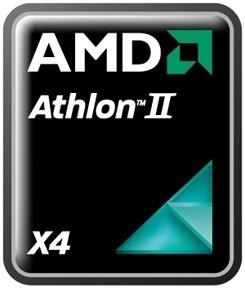
AMD has not had the greatest acceptance of the K10 architecture, especially when released and the TLB bug that caused the L3 cache to become completely useless reared its ugly head.
This is now a thing of the past for AMD, but its stigma still makes its mark. Phenom was late due to the TLB bug and the repaired version didn't offer much of an increase that AMD said it would with the L3 cache enabled.
Moving ahead today though, Phenom II is one of the most versatile processors, due to its dual mode memory controller. You can easily put a Phenom II processor into any AM2+ motherboard and use it with DDR2 memory or AM3 based motherboard and run it on DDR3 memory and this is one thing AMD definitely got right.
AMD's own marketing strategy for Phenom II is for high-end market, and it leaves a gap for the mainstream segment, but not anymore we see.
Today AMD has its newest addition to the K10 family out using the Athlon naming, which gave them such a good hit all those years ago. Introducing the first quad-core mainstream CPU from AMD, which is dubbed the Athlon II X4.
We have the 620 model with us here today - how well does it perform? What does it offer? Let's find out!
What's New?
The Athlon II processor is AMD's newest addition to the K10 family, based around the same core design, the Athlon II carries many of the improvements that the Phenom II processor currently supports and we will run down a few of them now for you.
- Dual Mode Memory
AMD's dual mode memory controller supports both a DDR2 and DDR3 Dual Channel memory controller on the single CPU. This allows for a seamless upgrade path allowing users with current AM2+ motherboards to use the Phenom II and Athlon II processors in their current motherboards with DDR2 memory, while allowing upgrade path to DDR3 at a later date.
- Caches
This is where Athlon II makes its distinction from the Phenom II line. Athlon II has had a cache cut done in order to save money on production as well as to reduce its overall performance.
Phenom II processors come with three caches - a Level 1 cache, a Level 2 cache and a shared Level 3 cache. Athlon II has no Level 3 cache integrated to the System Command Queue or better known as the integrated Northbridge. The L2 and L1 cache sizes are identical to the Phenom II processors, so no changes have been made there.
Looking at the Athlon II processor there isn't much different at all apart from the writing on the top of the IHS. The same AM3 938-pin package is used, which we hope AMD will change with AM4 socket to go pinless similar to how Opteron has now gone.
The current line-up of Athlon II X4 processors from AMD shows only two processors on their map, the 620 and the 630. The 620 processor that we are looking at today comes clocked at 2.6 GHz where the 630 comes clocked in at 2.8 GHz. Both share the same quad-core design, cache structure and socket support.
Overclocking
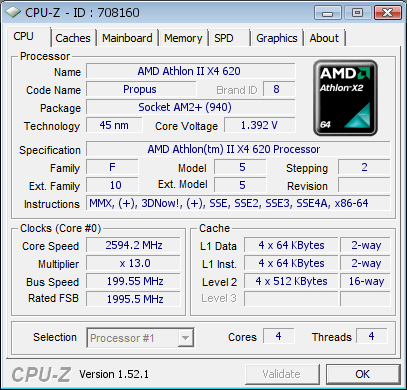
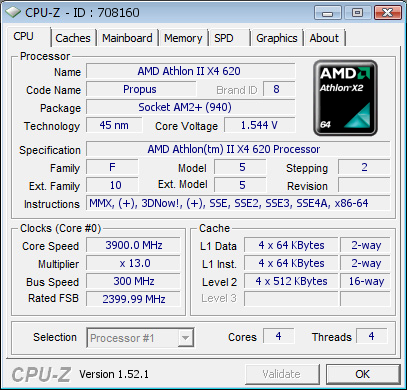
Overclocking the Athlon II processor was extremely impressive!
We were sent the A2 620 clocked at 2.6 GHz and with little effort, we managed to clock this baby all the way to 3.9 GHz using air cooling. Unfortunately 4 GHz was out of reach as the CPU just wouldn't get up there; however 3.9 GHz out of a 2.6 GHz processor was extremely impressive indeed.
You can see the validation for the CPU here.
As all overclocking results are dependent on the hardware you use your results may vary. Results of our overclocking tests are included in the performance section with the stock scores.
Important Editor Note: Our maximum overclocking result is the best result we managed in our limited time of testing the motherboard. Due to time constraints we weren't able to tweak the motherboard to the absolute maximum and find the highest possible FSB, as this could take days to find properly. We do however spend at least a few hours overclocking every motherboard to try and find the highest possible overclock in that time frame. You may or may not be able to overclock higher if you spend more time tweaking or as new BIOS updates are released. "Burn-in" time might also come into play if you believe in that.
Test System Setup and Comments
Test System
Mainboard ASRock M3A785GXH/128M (Supplied by ASRock)
Memory: 2GB Kingston KHX12800D3T1K3/3GX (Supplied by Kingston)
Hard Disk: Intel X25-M 80GB SSD (Supplied by Kingston)
Graphics Card: GIGABYTE GTX285 1GB (flashed to stock BIOS) (Supplied by GIGABYTE)
Cooling: Cooler Master Hyper 212 (with an extra fan) (Supplied by Cooler Master)
Operating System: Microsoft Windows 7 Ultimate 64-bit RTM
Drivers: ATI Catalyst 9.8
Today's tests have been done on AMD's "Mainstream" Platform with one exception, that being the graphics card.
We used AMD's 785G platform thanks to our impressive ASRock motherboard and a fresh install of Windows 7 Ultimate 64-bit RTM. This gives us a real good idea of just how well we can get things to move.
We have included the Phenom II 955 Black and the AMD Core 2 Duo E8500 as comparisons.
Synthetic Tests - Part I
With any system you will want to see a combination of synthetic testing and real-world. Synthetics give you a static, easily repeatable testing method that can be compared across multiple platforms. For our synthetic tests we use Everest Ultimate, Sisoft Sandra, Futuremark's 3D Mark Vantage and PCMark Vantage, Cinebench as well as HyperPi. Each of these covers a different aspect of performance or a different angle of a certain type of performance.
CPU Raw Performance
For CPU Raw Performance we want to look at the theoretical performance numbers. This means how many GigaFlops you can get, how many megapixels etc. We also test for memory bandwidth. As memory controllers are moved onto the CPU and away from the Northbridge we see memory performance increasing but also becoming much more CPU dependent than mainboard dependent.
To test memory and Raw CPU performance we use a combination of Sisoft Sandra and HyperPi 0.99.
Sisoft Sandra
Version and / or Patch Used: 2009 SP3c
Developer Homepage: http://www.sisoftware.net
Buy It Here
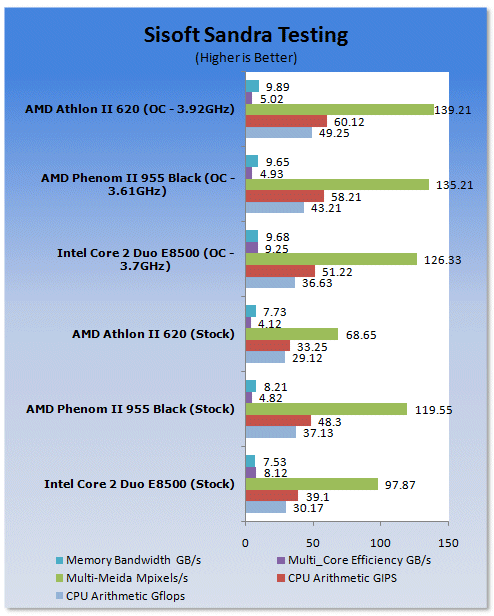
First off in Sandra we can see that the CPU doesn't lack too much behind the Phenom II - the extra cache loss doesn't hamper things much.
When we overclock the CPU to 3.9 GHz, it is able to beat the stock Phenom II results quite impressively as well as the Phenom II's overclocked results, which we only managed 3.6 GHz.
It seems that the extra cache on the Phenom II can hamper overclocking.
HyperPi 0.99
Version and / or Patch Used: 0.99
Developer Homepage: www.virgilioborges.com.br
Product Homepage: www.virgilioborges.com.br
Download It Here
HyperPi is a front end for SuperPi that allows for multiple concurrent instances of SuperPi to be run on each core recognized by the system. It is very dependent on CPU to memory to HDD speed. The faster these components the faster it is able to figure out the number Pi to the selected length. For our testing we use the 32M run. This means that each of the four physical and four logical cores for the i7 (four total on the PII x4 955 and Core i5) is trying to calculate the number Pi out to 32 million decimal places. Each "run" is a comparative to ensure accuracy, and any stability or performance issues in the loop mentioned above will cause errors in calculation.
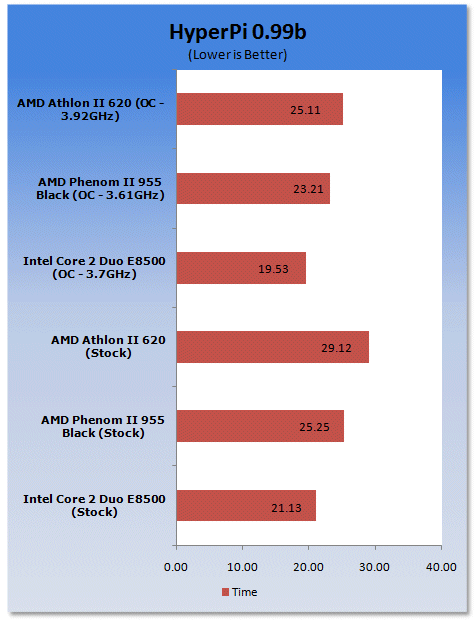
Into HyperPI and the Athlon II scores surprisingly well. Core 2 Duo E8500 still leads this even though it only hit 3.7 GHz; its superior architecture helped it win.
Synthetic Tests - Part II
Overall System performance and Gaming
Here is where we dig out the FutureMark tests.
PCMark Vantage
Version and / or Patch Used: 1.0.0.0
Developer Homepage: http://www.futuremark.com/
Product Homepage: www.futuremark.com
Buy It Here
For overall system performance we use PCMark Vantage, this is run in both x86 and x64 mode to give the best indication of performance.
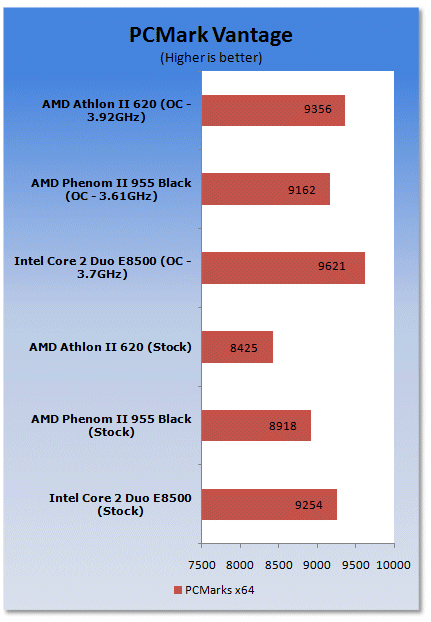
In synthetic system tests we see that the AMD Athlon II isn't hampered by its lack of L3 cache. It is slower than the 955 at stock, but that's due to a slower clock speed. When we overclock the Athlon II, it stomps on the Phenom II.
For synthetic gaming tests we used the industry standard and overclockers bragging tool 3DMark Vantage. This is a test that strives to mimic the impact modern games have on a system. FutureMark went a long way to change from the early days of graphics driven tests to a broader approach including physics, AI, and more advanced graphics simulations. 3DMark Vantage uses the DX10 API in addition to having support for PhysX. Due to the PhysX support and our use of an nVidia GPU we run with PhysX enabled and disabled to give you the best indication of real system performance. For testing we use the Performance test run.
3DMark Vantage
Version and / or Patch Used: 1.0.1
Developer Homepage: http://www.futuremark.com/
Product Homepage: www.futuremark.com
Buy It Here
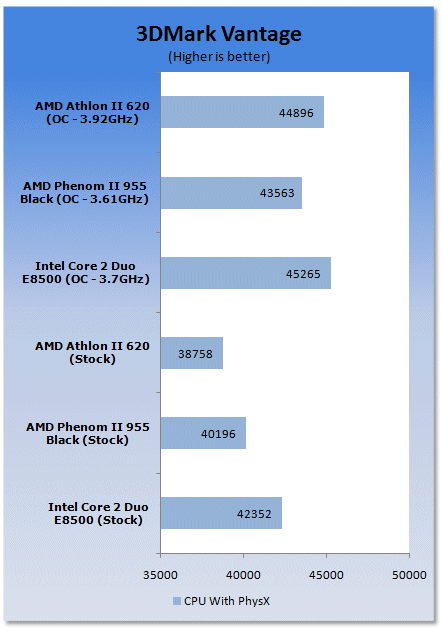
This is where we start to see things kick into a higher gear. The CPU score at stock for the Athlon II isn't as impressive as the Phenom II, however overclocking really put this to bed.
Cinebench R10 x64
Version and / or Patch Used: R10
Developer Homepage: http://www.maxon.net/
Product Homepage: www.maxon.net
Download It Here
Cinebench is a synthetic rendering tool developed by Maxon. Maxon is the same company that developed Cinema4D another industry leading 3D Animation application. Cinebench R10 tests your systems ability to render across a single and multiple CPU cores. It also tests your systems ability to process OpenGL information.
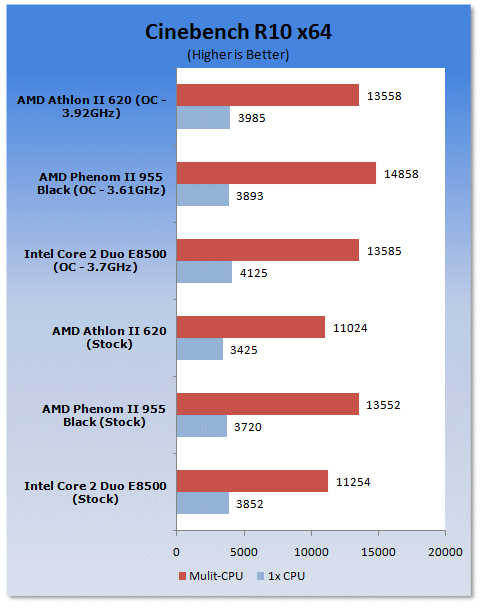
This is where we started to see the Athlon II loose a bit of ground to the Phenom II; L3 cache got used a bit here. When we overclocked, the Phenom II closed in right behind the Athlon II.
Real-World Tests Part I
Real-world testing allows us to see how well a product will perform when used in the same manner as it would be in your house or office. It is an important side to performance testing as it can uncover hidden glitches in the way a product performs.
For real-world testing we use some common applications and functions. We test with LightWave 3D for rendering performance, AutoGK for Transcoding from DVD to AVI and two games for gaming testing.
Rendering
Rendering of 3D Animation is a system intensive endeavor. You need good CPU, Memory and HDD speed to get good rendering times. For our testing we use LightWave 3D. This software from Newtek is an industry standard and has several pre loaded scenes for us to use.
LightWave 3D
Version and / or Patch Used: 9.6
Developer Homepage: http://www.newtek.com
Product Homepage: http://www.newtek.com/lightwave/
Buy It Here
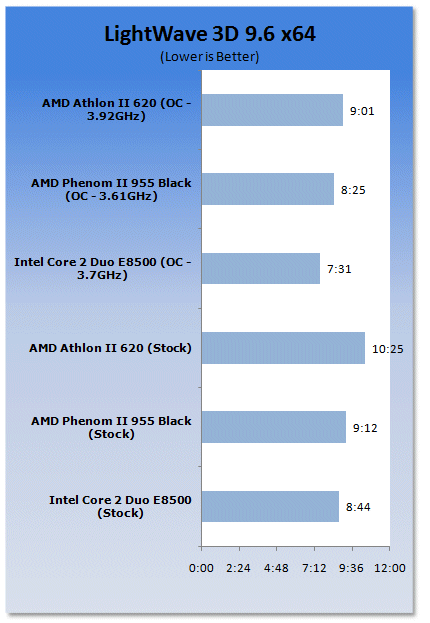
Rendering tests in real-world is where the Athlon II looses out to the Phenom II processor, even overclocking didn't help it out here.
AutoGK
Version and / or Patch Used: 2.55
Developer Homepage: http://www.autogk.me.uk/
Product Homepage: http://www.autogk.me.uk/
Download It Here
AutoGK stands for Auto Gordian Knot; it is a suite of transcoding tools that are compiled into and easy to install and use utility. It allows you to transcode non-protected DVDs and other media to Xvid or Divx format. For our testing purposes we use a non-DRM restricted movie that is roughly 2 hours in length. This is transcoded to a single Xvid AVI at 100% quality.
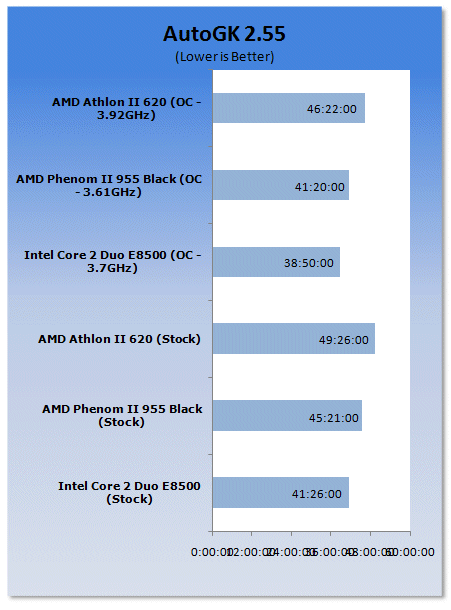
Again in real-world encoding the lack of L3 cache does hamper the Athlon II somewhat.
Real-World Tests Part II
Here we have our real gaming tests. Each of the games we chose uses multiple cores and GPUs. They are able to stress the system through use of good AI. Both have decent positional audio that adds impact to the sound subsystem of the board. We ran each game through the level or parts listed and recorded frame per second using FRAPS. This brings the whole game into play.
*** A word on gaming as a CPU test; ***
Gaming is no longer a good indication of true CPU performance. As you push over 1024x768 resolution you see the GPU take over and dominate the performance scale. This is even evident in 3DMark Vantage testing. The CPU score can be through the roof and still not add more than a handful of points to the overall score. This does not mean the gaming is not of value for testing. It can show an issue with the CPU and gaming if the CPU is unable to meet the speed expected of a certain GPU. But for the most part you are not going to see great differences in performance between CPUs in high resolution gaming.
Cryostasis: Sleep of Reason
Version and / or Patch Used: 1.0
Timedemo or Level Used: From Ship Entry until third Spirit Journey
Developer Homepage: http://www.505games.co.uk
Product Homepage: http://cryostasis-game.com
Buy It Here
Cryostasis : Sleep of Reason is an interesting game it is heavy on PhysX so to play it properly you will really want an nVidia GPU. However that aside it can be immersive, imagine Myst with Guns and monsters. One of the cool concepts is the spirit journeys. These allow you to enter the past of lost souls. You have to change their past to change your future. Each one makes for a nice diversion and requires you to think about what you are doing and how it will affect the outcome of the game. The Settings we used are shown below.
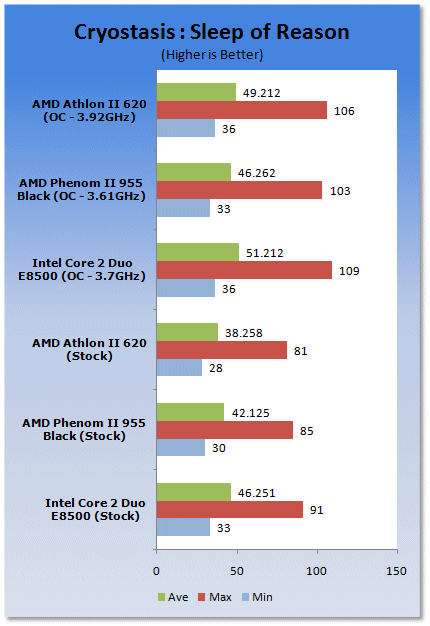
In our first gaming test we see that the Athlon II's lower clock speed at stock does hamper it a bit, however when we overclock the CPU to 3.9 GHz, it gives the Phenom II a loss and even comes right up on the Core 2 Duo.
FarCry 2
Version and / or Patch Used: V1.00
Timedemo or Level Used: Clearing the Safe house through to the Rescue
Developer Homepage: http://www.ubi.com
Product Homepage: http://farcry.us.ubi.com
Buy It Here
FarCry 2 is a large sandbox style game. There are no levels here so as you move about the island you are on you do not have to wait for the "loading" sign to go away. It is mission driven so each mission is what you would normally think of as the next "Level". In the game to take the role of a mercenary who has been sent to kill the Jackal, unfortunately your malaria kicks in and you end up being found by him. Long story short you become the errand boy for a local militia leader and run all over the island doing his bidding. Settings we used for testing are shown below.
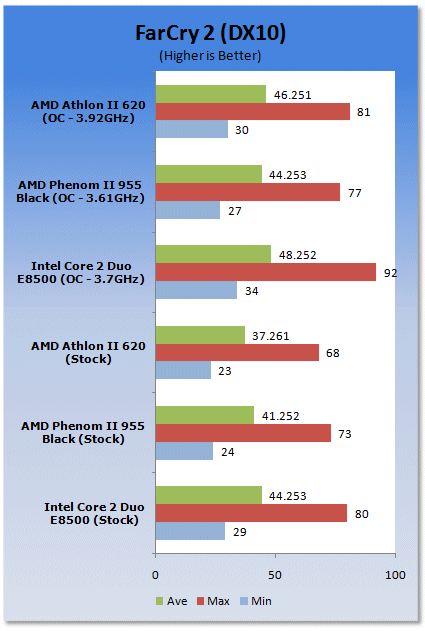
We see the same thing with our Far Cry 2 testing, Athlon II is a bit weak until overclocked and then it comes out all guns blazing.
Final Thoughts
It seems that with Intel's Lynnfield hitting the shelves now, AMD is trying to get as many CPU's as they can out to compete.
While it's a good effort by AMD to keep the line up and running, it really seems that the days of K10 are numbered in terms of performance crowns. AMD needs to really make things up in volume and keep prices as low as possible to make their CPU's more attractive.
AMD's Athlon II is no technological marvel - it doesn't support any new features that the Phenom II already has, in fact it's been stripped of its L3 cache, so any thoughts of this CPU being the savior are gone. This is purely a mainstream product designed to keep AMD in the game.
The one thing that the Athlon II has in abundance is overclocking headroom. Our stock sample 2.6 GHz part was able to hit 3.9 GHz on air. And maybe with better cooling, more time and some fine tuning, overclocking to 4 GHz and beyond might be obtainable.
To us it seems that the L3 cache on Phenom II processors hampers the clock speeds quite a bit. We used the same motherboard that we overclocked the Phenom II with; it only managed a few megahertz extra FSB to increase in speed. But with the Athlon II, we managed to clock things right to the max, as we had to rely on FSB as the multipliers were locked.
AMD Athlon II is a cheap overclocking CPU that really isn't worth it at stock, the real gem of this CPU is the ability to overclock. If you're going to stick only to stock clock speeds go with the Phenom II, but for overclocking take the Athlon II and clock it through the roof.

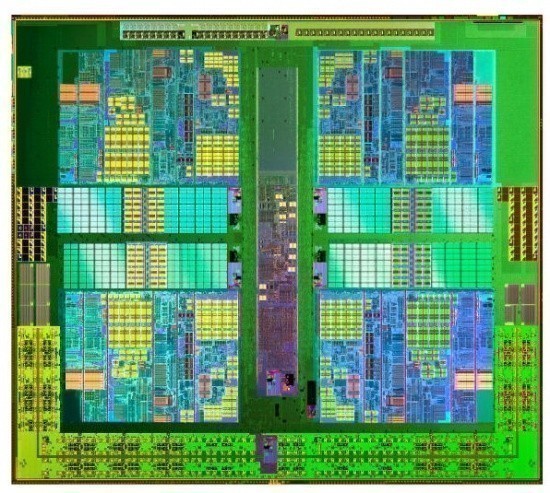
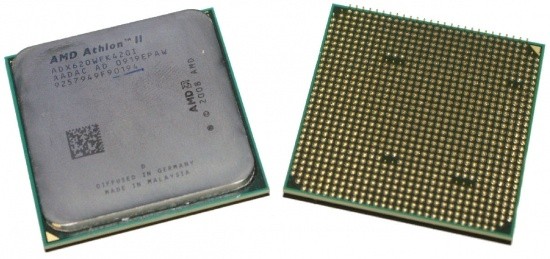

 United
States: Find other tech and computer products like this
over at
United
States: Find other tech and computer products like this
over at  United
Kingdom: Find other tech and computer products like this
over at
United
Kingdom: Find other tech and computer products like this
over at  Australia:
Find other tech and computer products like this over at
Australia:
Find other tech and computer products like this over at  Canada:
Find other tech and computer products like this over at
Canada:
Find other tech and computer products like this over at  Deutschland:
Finde andere Technik- und Computerprodukte wie dieses auf
Deutschland:
Finde andere Technik- und Computerprodukte wie dieses auf